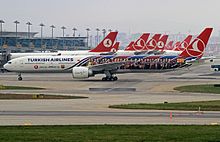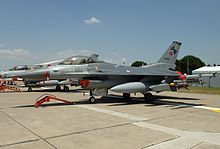Aviation in Turkey
 From Wikipedia - Reading time: 8 min
From Wikipedia - Reading time: 8 min
This article needs to be updated. (July 2020) |
Turkey is an emerging aviation hub at the intersection of Europe with emerging markets in the Middle East, the Caucasus and Northern Africa.[1]
Airlines
[edit]
In 1983, the Turkish airline market was liberalized. While before, only public companies were allowed to serve the country's airports, with the enactment of the 1983 Civil Aviation Law, private companies were admitted. As the regulation failed at setting up a competitive environment, the quasi-monopoly of Turkey's national flag carrier Turkish Airlines was further reinforced. It was only in 2003, that major barriers for market entry were erased, leading to a more competitive market, though Turkish Airlines continued to benefit from state support.[2]
As of 2023, Turkish Airlines is one of the major airlines of the world, particularly by its number of international passengers with 83.4 million passengers.[3] Operating scheduled services to 122 countries and 304 destinations all around the world. The Turkish airlines flies to more countries than any other airlines in the world.[4]
Airports
[edit]
Since the 2000s, the country has seen an extraordinary development in civil aviation with a growth ten times faster than the world average. While Turkey's airports only handled 34 million passengers in 2003, the number rose to 105 million in 2010, 52 percent of which were on international flights.[5] In 2012, Turkish airports handled 130 million passengers, making it the sixth-largest aviation market in Europe.[6]
In 2015, Istanbul's Atatürk Airport handled 61.8 million passengers making it the world's 11th busiest airport at the time.[7] The aging airport was however replaced by the larger Istanbul Airport. With the world's largest airport terminal, initially serving 90 million passengers the new airport will massively expand the passenger capacity, with two more terminals being planned summing up to 150 million passengers per year.[8] By 2035, the new airport is projected to be the world’s largest airport serving 260 million passengers annually.[9]
Under Transport Minister Binali Yıldırım, numerous new airports were opened, starting with Zonguldak Airport and Şanlıurfa GAP Airport and the controversial Hatay Airport in 2007. Amasya Merzifon Airport followed in 2008, while Gazipaşa Airport serving Antalya and Gökçeada Airport serving Çanakkale were opened in 2010. Zafer Airport serving the cities of Afyonkarahisar, Uşak and Kütahya in 2012, Iğdır Airport also in 2012 and Şırnak Airport followed in 2013.[10] Erhaç Airport in Malatya and Cengiz Topel Airport in Kocaeli, previously operating as military air bases, were opened to civil aviation in 2007 and 2011 respectively. A new international terminal at İzmir's Adnan Menderes Airport was opened in 2006, followed by a new domestic terminal in 2014.[11] New terminal buildings for Erzincan Airport and Mardin Airport were both opened in 2011 and a new international terminal for Milas–Bodrum Airport was completed in 2012.
In the same period, many other airports were refurbished,[12] including the Tokat, Kahramanmaraş, Sivas, Gaziantep and Çanakkale, Balıkesir and Kars Harakani airports reopened in 2006 and 2007.[13][14][15] Major improvements to Balıkesir Koca Seyit Airport and Kastamonu Airport were completed in 2010 and 2013 respectively.
Airport construction
[edit]In the airport sector, construction company Limak İnşaat grew into the position as one of the regional market leaders. In 2007, a Limak joint venture with French company Aéroport de Lyon won the concession tender for Pristina International Airport Adem Jashari.[16] In 2015, the company won the tender for a new terminal building at Kuwait International Airport.[17] Limak is also part of the joint venture that won the tender for Istanbul Airport, Turkey's largest PPP infrastructure project, and due to become the world's largest airport.[8]
Aerospace industry
[edit]
Turkey has sought for a national aerospace industry since the foundation of the Republic. Under the auspices of the Turkish Ministry for Industry and Technology, Turkey's aircraft industry today is centered on the Turkish Aerospace Inc. (TAI) - founded in 1984 - expanding on a predecessor established in 1973,[18] and Tusaş Engine Industries (TEI). Several indigenous fighter aircraft programs are under development, the most ambitious of which is the air superiority fighter TAI KAAN (started in 2011) for the Turkish Air Force and future export purposes. TAI produces the trainer and light combat aircraft TAI Hürkuş and TAI Hürjet, the attack helicopter T129 ATAK, the UAVs TAI Anka and TAI Aksungur, and several reconnaissance and military satellites such as the Göktürk-3. The private company Baykar is known for its proven tactical UAV Bayraktar TB2.
References
[edit]- ^ "Civilian Aerospace". Turkey Investment and Business Guide Volume 1 Strategic and Practical Information. Washington, D.C.: International Business Publications. 2015. p. 99 f. ISBN 978-1-329-18235-6.
- ^ Erik den Hartigh; Hatice Küçükönal (2012). "The Turkish aviation system and the strategy of Turkish Airlines". In R. Curran; et al. (eds.). Air Transport and Operations: Proceedings of the Third International Air Transport and Operations Symposium 2012. Amsterdam: IOS Press. pp. 231–245. ISBN 978-1-61499-118-2.
- ^ "Turkish Airlines carried 83.4M passengers in 2023". www.aa.com.tr. Retrieved 2024-01-16.
- ^ "About | Turkish Airlines | Routes". www.routesonline.com. Retrieved 2024-01-16.
- ^ "Civilian Aerospace". Turkey Transportation Policy and Regulations Handbook - Strategic. Washington, D.C.: International Business Publications. 2015. p. 60 f. ISBN 978-1-329-16459-8.
- ^ The Report: Turkey 2013. Oxford Business Group. 2013. p. 153. ISBN 978-1-907-06580-4.
- ^ "2015 Airport Traffic Statistics" (PDF). Port Authority of New York and New Jersey. 2016-04-01. Archived from the original (PDF) on 2016-05-06. Retrieved 2016-04-16.
- ^ a b "World's biggest airport under construction in Istanbul". The Worldfolio. 19 November 2015. Archived from the original on 12 June 2017. Retrieved 22 May 2016.
- ^ Hofmann, Kurt (20 April 2016). "Kotil: Istanbul New Airport to be world's largest". Air Transport World.
By 2035, the New Airport should serve 260 million passengers annually, making it the world's largest airport, Turkish Airlines president and CEO Temel Kotil told ATW.
"Kotil: Istanbul New Airport to be world's largest | Airports & Routes content from ATWOnline". Archived from the original on 2016-04-23. Retrieved 2016-04-23.{{cite web}}: CS1 maint: bot: original URL status unknown (link) - ^ "Hatay havaalanına kavuştu". Archived from the original on 2016-06-03. Retrieved 2016-05-22.
- ^ "266 milon Euro'luk Adnan Menderes İç Hatlar Terminali hizmete girdi".
- ^ SHGM. "Türkiye'de Atıl Havaalanı Kalmayacak. - Sivil Havacılık Genel Müdürlüğü".
- ^ "Kahramanmaraş Havaalanı uçuşlara açıldı". www.airporthaber.com.
- ^ SHGM. "Tokat Havaalanı, yeniden hizmete açıldı... - Sivil Havacılık Genel Müdürlüğü".
- ^ SHGM. "Çanakkale Havaalanı yeniden hizmete açıldı. - Sivil Havacılık Genel Müdürlüğü".
- ^ Ali Aslan Kiliç (14 August 2010). "Kosovo to open to world with Turkish-built airport". Today's Zaman. Archived from the original on 19 August 2010. Retrieved 22 May 2016.
- ^ "Limak to construct new terminal at Kuwait International Airport". Daily Sabah. 19 August 2015. Archived from the original on 15 March 2016. Retrieved 22 May 2016.
- ^ Sören Eriksson (2016). "Newly industrialising economies and the aircraft industry: economic and industrial policy views in Asia". In Eriksson; Steenhuis (eds.). The Global Commercial Aviation Industry. Routledge. p. 236. ISBN 978-0-415-81821-6.
 KSF
KSF